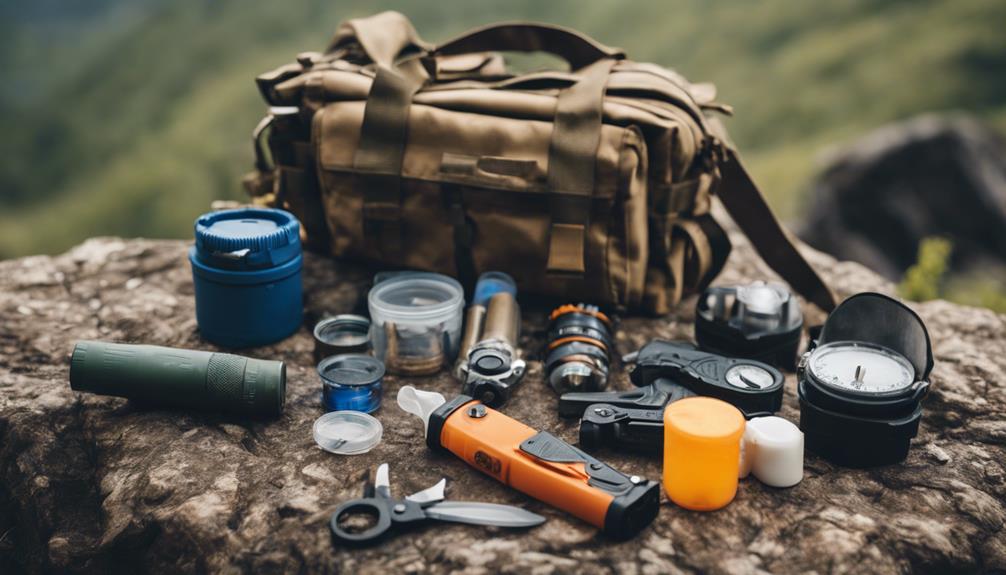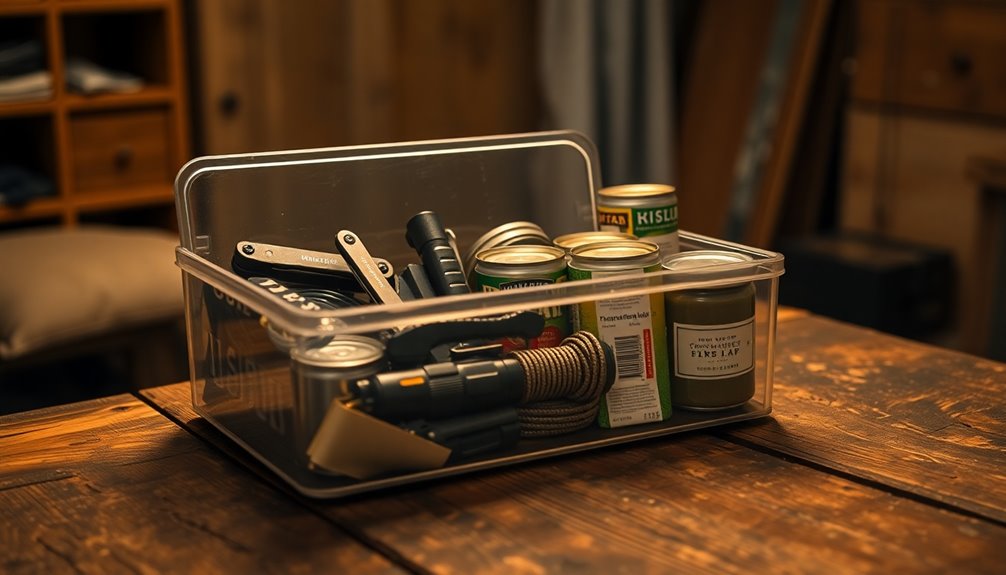Mastering map and compass skills is essential for survival. Start by understanding map basics, like scales and symbols, to interpret terrain features. Next, orient your map using landmarks and align it with the compass for direction. When using the compass, set it to magnetic north and make sure the needle points accurately. Plot your course using waypoints and triangulation to determine your location. Regular practice boosts your confidence and sharpens your abilities. With these core skills, you'll navigate the wilderness effectively. Stick around, and you'll discover even more techniques to enhance your outdoor adventures.
Key Takeaways
- Understand map scales and symbols to interpret distances and features accurately for effective navigation.
- Use a compass to align with magnetic north and ensure correct orientation of your map.
- Practice triangulation by identifying multiple landmarks to confirm your location and improve accuracy.
- Regularly check compass alignment and adjust for magnetic declination to maintain a steady course.
- Engage in simulation exercises to build confidence and proficiency in reading maps and using a compass.
Understanding Map Basics

When you plunge into the world of map reading, understanding the basics is essential for effective navigation. First, familiarize yourself with the map scale, which shows the relationship between the distances on the map and the actual distances on the ground. This helps you gauge how far you need to travel. Next, pay attention to the marginal information, including the legend, contour lines, north point diagram, and grid magnetic angle. These elements provide vital context for interpreting the map accurately.
Topographic maps are particularly useful, as they illustrate terrain features, elevations, and landmarks. Learn to read contour lines, as they reveal elevation changes and geographical features like valleys and ridges. You'll also want to master grid references, which enable you to pinpoint specific locations easily. Additionally, understanding navigation mastery through map reading and compass use is crucial for ensuring safety in wilderness settings.
Orienting the Map
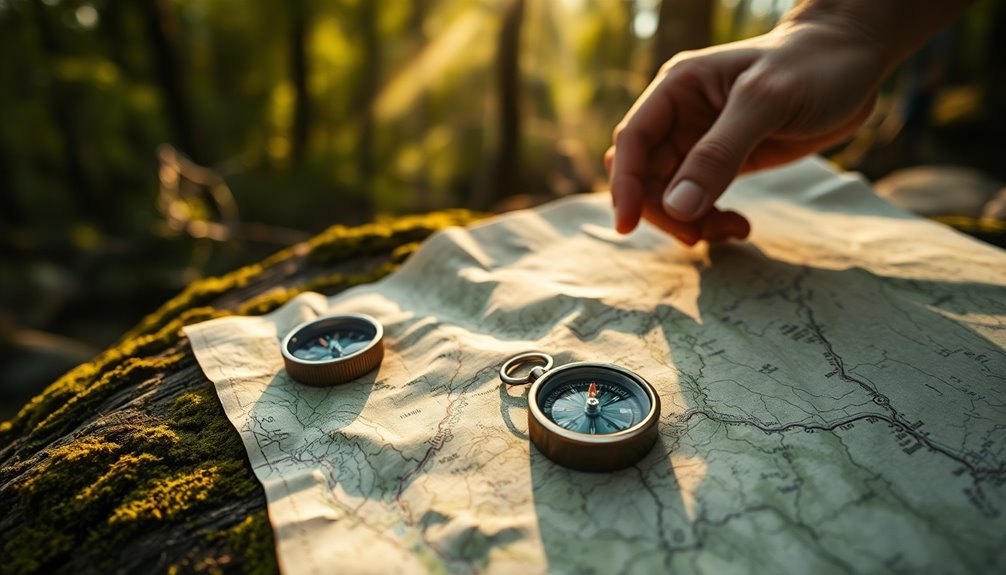
To orient your map effectively, start by aligning it with the surrounding landmarks you see. Use your compass to guarantee the map's north-south axis matches the Earth's magnetic north. This simple technique will help you navigate accurately and confidently in unfamiliar territory. Additionally, participating in a Wilderness Navigation Class can significantly enhance your skills in map reading and compass usage.
Aligning Landmarks and Map
Five essential steps can help you align landmarks with your map effectively. First, hold the map in line with your direction of travel, ensuring it matches the ground ahead. Next, use a compass to orient the map; make sure the North Lines on the map are parallel to the compass needle, pointing toward the map's north end.
To concentrate on your current leg, fold the map along your route. As you navigate, continually update the map's orientation as your direction changes to stay aligned with the terrain. Understanding the symbols used on maps is also crucial for effective navigation.
Identify large features, like mountain ranges or lakes, to confirm your location on the map. Smaller features, such as paths or boulders, serve as additional reference points. Recognize changes in the landscape—like clearings or elevation shifts—as valuable indicators.
Match these landmarks on your map with what you see on the ground to maintain your orientation. In low-visibility conditions, rely on audible landmarks, like a river's sound, or tactile ones, such as the texture of tree bark, to guide you. By integrating these techniques, you can navigate more confidently through unfamiliar terrain.
Compass Orientation Techniques
Effective compass orientation techniques are vital for maneuvering accurately with a map. By setting up your compass correctly and aligning it with your map, you can guarantee that you navigate effectively. Follow these steps to orient your map:
- Set your compass to magnetic north, adjusting for local declination if needed.
- Align the edge of the compass with any north-south line on your map.
- Rotate both the map and compass until the magnetic needle aligns with the orienteering arrow (remember: Red in the Shed).
- Confirm the orienting lines on the compass dial match the north-south gridlines on the map.
Once you've oriented your map, match it to the terrain. Turn the map to face the same direction as the ground, and check that the features align with what's in front of you. Regular checks are essential—verify your orientation after any change in direction or when encountering new linear features. Map orientation should be checked every time the map is viewed to prevent navigation errors. Always keep the map flat and stable for the best accuracy. By consistently applying these techniques, you'll navigate with confidence and clarity, enhancing your outdoor experience.
Using the Compass
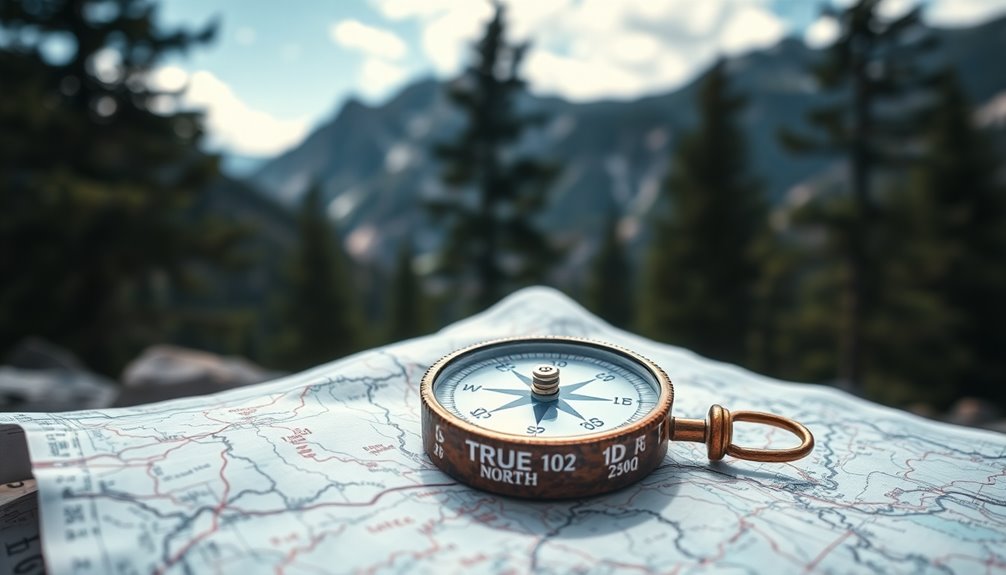
A compass is an indispensable tool for navigation, guiding you through unfamiliar terrain with confidence. To get accurate readings, hold your compass on a level surface. If you can't find one, use your body to keep it steady. Make certain to keep it away from metal objects and electronic devices that could interfere with its accuracy. While taking readings, keep the compass still.
To align your compass with magnetic north, rotate your body until the magnetic needle aligns with the north indicator. Point the direction-of-travel arrow toward your desired destination. Remember to check for magnetic declination and adjust accordingly.
To orient your map, rotate both the map and compass until the north-seeking arrow aligns with the orienting arrow. Verify the left edge of the compass matches the left side of the map, and use heavy objects to hold the map in place. Understanding magnetic declination is crucial for accurate navigation, as it helps you adjust your compass readings to account for the differences between magnetic north and true north.
In various conditions, compasses are reliable since they don't need batteries or signals. Some even glow in the dark for nighttime navigation. Protect your compass with a pouch to keep it safe, and remember, mastering these skills is vital for survival.
Plotting a Course
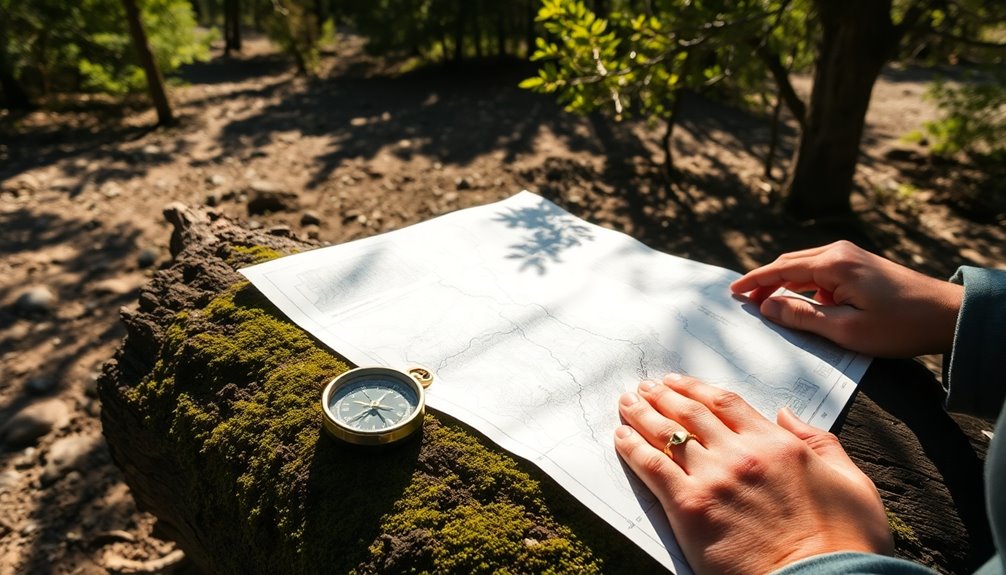
When plotting a course, you need to master compass alignment techniques to guarantee your direction is spot on. Once you've got that down, consider waypoint navigation strategies to break up your journey into manageable segments. This approach not only simplifies navigation but also helps you stay on track throughout your adventure. Additionally, having a good understanding of traditional navigation tools can significantly enhance your confidence and safety in the wilderness.
Compass Alignment Techniques
Compass alignment techniques are essential for maneuvering accurately across various terrains. Mastering these skills allows you to navigate confidently, ensuring you stay on the right path.
To start, orient your map by rotating it until the north-south grid lines match the direction of the compass needle. Use the orienting arrow on your compass to point towards true north on the map. Remember to adjust for magnetic declination, which can be found on the map or online.
When setting your bearing, follow these steps:
- Place your compass on the map, connecting your current location to your destination.
- Align the direction of travel arrow with the destination point.
- Rotate the compass dial until the orienting lines are parallel to the map's grid lines.
- Read the bearing from the index line, indicating degrees from north.
Once you've transferred the bearing to your compass, hold it level and align the north arrow with the magnetic needle. As you navigate, periodically check and adjust your bearing to maintain accuracy. Understanding map scales is also crucial for estimating distances while navigating. With practice, these alignment techniques will enhance your navigation skills and boost your confidence in the wild.
Waypoint Navigation Strategies
Maneuvering through unfamiliar terrain often requires more than just compass alignment; it involves plotting a course using waypoints. Waypoint navigation offers a structured approach to guide you through complex landscapes. You can define your travel route by selecting specific waypoints that mark critical points along your path. Navigating by landmarks allows you to visually recognize and verify your position as you move through the terrain. This method provides a more hands-on and intuitive approach to wayfinding, adding an extra layer of security to your journey. By blending waypoint navigation with the use of landmarks, you can enhance your overall navigation experience and stay on course with greater confidence.
Utilizing algorithms like Reinforcement Learning (RL) or Rapidly Exploring Random Trees (RRT) can enhance your navigation experience. RL, inspired by machine learning, evaluates travel distance and energy efficiency, guaranteeing you choose the finest route. Meanwhile, RRT efficiently explores spaces, making it ideal for dynamic environments. This method is a part of global path planning, which relies on preexisting environmental data for trajectory computation.
As you navigate, consider obstacle avoidance strategies. Bug algorithms help you circumnavigate or follow obstacles, recalculating your path as needed. The Follow the Gap Method (FGM) uses sensory data to identify the safest routes, factoring in gaps and safety parameters.
To test your navigation methods, simulate indoor environments or apply them in real-world scenarios. By evaluating travel distance, speed, and robustness, you can determine the effectiveness of your waypoint navigation strategies. Embracing these techniques will not only enhance your navigational skills but also guarantee a safer journey through unfamiliar terrain.
Determining Location

Determining your location accurately is essential for successful navigation, and using landmarks combined with bearings is a reliable method to achieve this. Start by identifying known landmarks—features like mountains, lakes, or trails that are visible and marked on your map. Make certain these landmarks are spread out, ideally with 120 degrees between each, for better accuracy. Natural features like hill crests work well, but steer clear of changing elements like trees or water bodies.
Next, take bearings on these landmarks by aligning the direction of travel arrow with the landmark and rotating the bezel until the needle lines up with north. Record the magnetic bearing and adjust it for declination to convert it to a true bearing. After that, plot these bearings on your map.
- Use at least two landmarks for a rough estimate.
- Opt for three or more landmarks for greater accuracy.
- Confirm your compass is aligned correctly for precise readings.
- Triangulate your position by finding the intersection of your plotted lines.
These steps will help you pinpoint your approximate location effectively. Additionally, mastering traditional compass skills enhances overall navigation confidence and safety in the outdoors.
Practical Navigation

Maneuvering effectively in the outdoors requires a solid understanding of both maps and compasses. Mastering practical navigation means you can confidently traverse various terrains without losing your way. When using topographic maps, pay attention to contour lines that indicate elevation changes. Familiarize yourself with key landmarks, like trails and water sources, and study the scale and symbols for accurate interpretation. Pre-trip planning is essential; note waypoints and potential hazards. Additionally, familiarity with map symbols can greatly enhance your navigation accuracy.
For compass navigation, grasp basic principles like finding north and setting bearings. Remember to account for magnetic declination and always keep the compass away from metal objects. Regularly check your compass to maintain your course.
Here's a quick reference table for essential navigation elements:
| Element | Map Usage | Compass Usage |
|---|---|---|
| Terrain Features | Identify trails and landmarks | Follow the course direction |
| Elevation | Read contour lines | Set bearings for elevation |
| Orientation | Use scale and symbols | Align compass with desired direction
Frequently Asked Questions
What Should I Do if I Get Lost While Navigating?
If you get lost while finding your way, first assess your situation. If it's safe, stay put to conserve energy. Avoid moving in the dark or bad weather to prevent injury. If necessary, find a safer spot, marking your original location for possible rescue. Before heading out, inform someone of your route and expected return time. Use any available navigation tools, and consider natural signs like the sun or stars to help guide you.
How Can I Improve My Map Reading Skills Quickly?
Did you know that nearly 80% of people struggle with map reading skills? To improve yours quickly, start by practicing with a variety of maps during your daily walks. Try orienting the map without using GPS, and compare features with real landmarks. Focus on understanding contour lines and the legend. Regularly check your progress against the terrain, and use a compass to enhance your navigation skills. Consistent practice will boost your confidence and ability.
What Are Common Mistakes to Avoid When Using a Compass?
When using a compass, avoid common mistakes like holding it unevenly or not keeping it level, which can lead to inaccurate readings. Make certain you're not near metal or electronic devices that could interfere with the needle. Always align the lubber line with your direction of travel and take back bearings to confirm your path. Remember to check your surroundings and adjust for magnetic variation to guarantee you're steering correctly.
How Do I Choose the Right Map for My Adventure?
To choose the right map for your adventure, consider the terrain you'll encounter. Look for topographic maps that highlight elevation changes and contour lines if you're hiking in rugged areas. Check the scale to guarantee it fits your needs and find a map that shows sufficient detail for your journey. Always use a current map, and familiarize yourself with the legend to understand symbols for water, trails, and landmarks.
Can I Rely Solely on My Phone's GPS for Navigation?
You might think relying solely on your phone's GPS is foolproof, but that's not always the case. While modern smartphones provide decent accuracy, they can falter in dense forests or urban settings where signals get blocked. Battery life can drain quickly, especially with GPS use. It's smart to have a backup plan, like a paper map or compass, to guarantee you stay on track no matter what challenges arise. Always be prepared!
Conclusion
Steering with a map and compass is like painting your path through the wilderness. Just as an artist blends colors to create a masterpiece, you blend skills to chart your journey. When I got lost during a hike, using my compass felt like finding the brushstroke that brought clarity to a chaotic canvas. By mastering these core skills, you'll transform uncertainty into confidence, ensuring every adventure becomes a vivid memory rather than a tangled mess of confusion.



